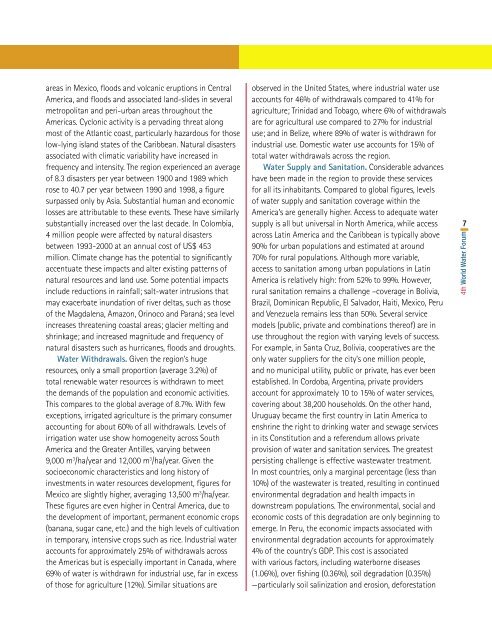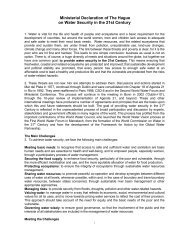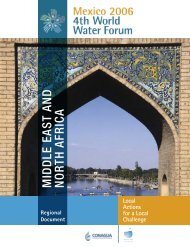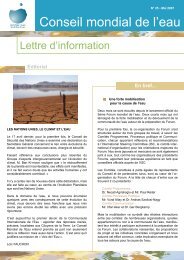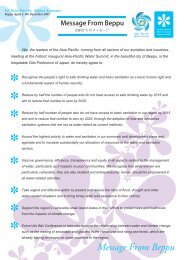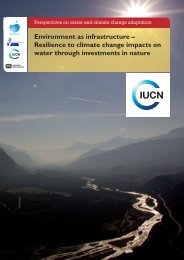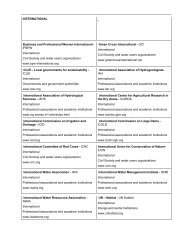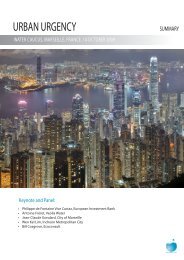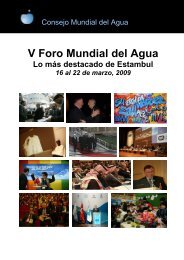EXECUTIVE SUMMARY64th <strong>World</strong> <strong>Water</strong> ForumAny discussion about water in the <strong>Americas</strong> has totake into consideration two basic background settings.First, the natural, cultural, and socioeconomic diversityof the <strong>Americas</strong> and second, the complex interactionsof water with the social, economic and politicalrealities of an increasingly globalized world.DiversityNature. Extending from the northern to the southernpole, the region encompasses a diversity of naturallandscapes, a wealth of natural resources and significantstocks of global biodiversity, with 4 of the world’s 10mega-diverse countries. Brazil has the world’s highestlevels of animal and plant richness, with between 10%and 20% of all species described. This is due in part tothe diverse topography and variable climatic conditions.Annual precipitation in the region averages around 1,084mm per year, contributing 44 000 km 3 of renewable waterresources, more than 55% of the global total. Rainfall ishighly seasonal, being concentrated in 4-5 months andunevenly distributed. Two-thirds of the region is classifiedas arid or semi-arid, with 30% receiving less than 300mm/yr, contrasting huge tracts of pristine forest, richin water. The Amazon, Orinoco, São Francisco, Paraná,Paraguay and Magdalena rivers carry more than 30% ofthe world’s continental surface water, with the Amazonbasin alone covering about one third of all South Americaand discharging 20% of all freshwater flowing from theworld’s rivers. The Amazon’s annual discharge (6,700 km 3 )is 5 times the volume of water from the Congo River,the world’s second largest river, and the number of fishspecies in the basin, estimated at over 3000, is thought tobe more than that found in all of the world’s basins. TheAmazon fixes more than a hundred trillion tons of carbonand vegetation in the basin releases 7 trillion tons of waterinto the atmosphere through evapotranspiration.Society, Culture, Politics and Economy. The<strong>Americas</strong> are characterized by diversity and starkcontrasts. The region encompasses 35 countries andan estimated 872 million people, who speak Spanish,Portuguese, English, French, or one of the more than400 indigenous languages. Ethnic and cultural diversityis also a characteristic of the region with SouthernMexico, Northern Central America, and the Andeancountries of Ecuador, Bolivia and Peru having the largestconcentrations of indigenous population. Accounting for30% of the world’s land mass, the region has only 14%of the global population and, with 22 inhabitants/km 2 , arelatively low population density compared to the worldaverage of over 43 inhabitants/km 2 and countries likeChina (133 inhabitants/km 2 ) and India (309 inhabitants/km 2 ). Despite the low population density, 75% of theregion’s people live in and around cities, the majority ofwhom are concentrated along the more that 617,000 kmof coastal margins, making it the most urbanized region inthe developing world. The region contributes 36% of theworld’s GDP, of which 95% is generated by Brazil, Canada,Mexico and the USA. The latter alone accounts for anestimated 80% of the total. These large global economiescontrast some of those from the smaller, low-incomecountries like Haiti and Nicaragua. Average GDP highlightssome of the challenges facing the region —per capita GDPaverages US$ 31,043 in North America, contrastingUS$ 2,240 in Central America, US$ 3,256 across SouthAmerica and US$ 1,192 among the Caribbean. In LatinAmerica and the Caribbean, about 128 million of theregion’s 525 million people live in poverty, with 50 millionconsidered extremely poor (living on less than $ 1 a day).<strong>Water</strong>-related issues also cannot be considered inisolation of the socio-political scenarios and tendenciesprevailing in the countries at a certain point in time. Inthe <strong>Americas</strong>, the intricate relationship of water with thesocial, cultural, environmental, economic, commercial,and political scenes and points of view has been Jauja 1for both advocates and opponents of various causes.As a result, the water discussion could not and has notremained solely within the realm of science or engineeringbut has transitioned into the social, economic and politicaldimensions of society.<strong>Water</strong>-related AspectsNatural Hazards. The region is particularly proneto natural disasters, the effects of which are oftenaccentuated by inequality and high urban concentrations.Risks include persistent droughts in the arid and semi-aridareas of northeast Brazil and the USA and the Northwest1Spanish popular term for heaven or bliss
74th <strong>World</strong> <strong>Water</strong> Forumareas in Mexico, floods and volcanic eruptions in CentralAmerica, and floods and associated land-slides in severalmetropolitan and peri-urban areas throughout the<strong>Americas</strong>. Cyclonic activity is a pervading threat alongmost of the Atlantic coast, particularly hazardous for thoselow-lying island states of the Caribbean. Natural disastersassociated with climatic variability have increased infrequency and intensity. The region experienced an averageof 8.3 disasters per year between 1900 and 1989 whichrose to 40.7 per year between 1990 and 1998, a figuresurpassed only by Asia. Substantial human and economiclosses are attributable to these events. These have similarlysubstantially increased over the last decade. In Colombia,4 million people were affected by natural disastersbetween 1993-2000 at an annual cost of US$ 453million. Climate change has the potential to significantlyaccentuate these impacts and alter existing patterns ofnatural resources and land use. Some potential impactsinclude reductions in rainfall; salt-water intrusions thatmay exacerbate inundation of river deltas, such as thoseof the Magdalena, Amazon, Orinoco and Paraná; sea levelincreases threatening coastal areas; glacier melting andshrinkage; and increased magnitude and frequency ofnatural disasters such as hurricanes, floods and droughts.<strong>Water</strong> Withdrawals. Given the region’s hugeresources, only a small proportion (average 3.2%) oftotal renewable water resources is withdrawn to meetthe demands of the population and economic activities.This compares to the global average of 8.7%. With fewexceptions, irrigated agriculture is the primary consumeraccounting for about 60% of all withdrawals. Levels ofirrigation water use show homogeneity across SouthAmerica and the Greater Antilles, varying between9,000 m 3 /ha/year and 12,000 m 3 /ha/year. Given thesocioeconomic characteristics and long history ofinvestments in water resources development, figures forMexico are slightly higher, averaging 13,500 m 3 /ha/year.These figures are even higher in Central America, due tothe development of important, permanent economic crops(banana, sugar cane, etc.) and the high levels of cultivationin temporary, intensive crops such as rice. Industrial wateraccounts for approximately 25% of withdrawals acrossthe <strong>Americas</strong> but is especially important in Canada, where69% of water is withdrawn for industrial use, far in excessof those for agriculture (12%). Similar situations areobserved in the United States, where industrial water useaccounts for 46% of withdrawals compared to 41% foragriculture; Trinidad and Tobago, where 6% of withdrawalsare for agricultural use compared to 27% for industrialuse; and in Belize, where 89% of water is withdrawn forindustrial use. Domestic water use accounts for 15% oftotal water withdrawals across the region.<strong>Water</strong> Supply and Sanitation. Considerable advanceshave been made in the region to provide these servicesfor all its inhabitants. Compared to global figures, levelsof water supply and sanitation coverage within theAmerica’s are generally higher. Access to adequate watersupply is all but universal in North America, while accessacross Latin America and the Caribbean is typically above90% for urban populations and estimated at around70% for rural populations. Although more variable,access to sanitation among urban populations in LatinAmerica is relatively high: from 52% to 99%. However,rural sanitation remains a challenge –coverage in Bolivia,Brazil, Dominican Republic, El Salvador, Haiti, Mexico, Peruand Venezuela remains less than 50%. Several servicemodels (public, private and combinations thereof) are inuse throughout the region with varying levels of success.For example, in Santa Cruz, Bolivia, cooperatives are theonly water suppliers for the city’s one million people,and no municipal utility, public or private, has ever beenestablished. In Cordoba, Argentina, private providersaccount for approximately 10 to 15% of water services,covering about 38,200 households. On the other hand,Uruguay became the first country in Latin America toenshrine the right to drinking water and sewage servicesin its Constitution and a referendum allows privateprovision of water and sanitation services. The greatestpersisting challenge is effective wastewater treatment.In most countries, only a marginal percentage (less than10%) of the wastewater is treated, resulting in continuedenvironmental degradation and health impacts indownstream populations. The environmental, social andeconomic costs of this degradation are only beginning toemerge. In Peru, the economic impacts associated withenvironmental degradation accounts for approximately4% of the country’s GDP. This cost is associatedwith various factors, including waterborne diseases(1.06%), over fishing (0.36%), soil degradation (0.35%)—particularly soil salinization and erosion, deforestation
- Page 1 and 2: A M E R I C A SDocumentoRegionalDoc
- Page 3 and 4: 4th WORLD WATER FORUMREGIONAL DOCUM
- Page 5: 54th World Water ForumFOREWORDThis
- Page 10 and 11: 104th World Water Forumresources; a
- Page 12 and 13: 124th World Water Forum1. INTRODUCT
- Page 14 and 15: 144th World Water Forum2. PRESENTAT
- Page 16 and 17: 3. CHARACTERISTICSof the regionThe
- Page 18 and 19: 184th World Water ForumThe Americas
- Page 20 and 21: 204th World Water Forumthe Congo Ri
- Page 22 and 23: 224th World Water Forumprevious rec
- Page 24 and 25: The Americas continue to face many
- Page 26 and 27: 264th World Water Forumdrinking wat
- Page 28 and 29: LocationGood Progress Some Steps In
- Page 30 and 31: 304th World Water ForumThe success
- Page 32 and 33: 324th World Water ForumWithin the c
- Page 34 and 35: 344th World Water Forumgreater effo
- Page 36 and 37: 364th World Water Forumwhat is cons
- Page 38 and 39: 384th World Water ForumArgentina an
- Page 40 and 41: 404th World Water Forumled to lower
- Page 42 and 43: Table 4.3 Irrigation techniques by
- Page 44 and 45: 444th World Water Forumneeds be pla
- Page 46 and 47: 464th World Water Forummillions of
- Page 50 and 51: Box 5.1 Some examples of associatio
- Page 52 and 53: 524th World Water ForumPrevailing s
- Page 54 and 55: een decommissioned and river restor
- Page 56 and 57:
564th World Water ForumThis was one
- Page 58 and 59:
584th World Water ForumBox 5.7 Exam
- Page 60 and 61:
604th World Water Forumthe rate of
- Page 62 and 63:
624th World Water Forum6. SUCCESSFU
- Page 64 and 65:
Figure 6.1 Local Actions by Region(
- Page 66 and 67:
Figures 6.5 and 6.6 Distribution of
- Page 68 and 69:
684th World Water Forumadvances hav
- Page 70 and 71:
704th World Water ForumInstitutiona
- Page 72 and 73:
724th World Water Forumof both surf
- Page 74 and 75:
744th World Water ForumCIA, (2005).
- Page 76 and 77:
764th World Water ForumGWP (2004).
- Page 78 and 79:
784th World Water Forumdel Agua en
- Page 81 and 82:
ANNEXES
- Page 83 and 84:
PARTICIPANTS4th World Water Forum S
- Page 85 and 86:
Participant E-Mail Organization Cou
- Page 87 and 88:
Participant E-Mail Organization Cou
- Page 89 and 90:
OBJECTIVE ORGANIZER CONTACT(Telepho
- Page 91 and 92:
OBJECTIVE ORGANIZER CONTACT(Telepho
- Page 93 and 94:
TELEPHONE FAX P.O. BOX E-MAIL OTHER
- Page 95 and 96:
CONTACT TELEPHONE FAX P.O. BOX E-MA
- Page 97 and 98:
CONTACT TELEPHONE FAX P.O. BOX E-MA
- Page 99 and 100:
TELEPHONE FAX P.O. BOX E-MAIL OTHER
- Page 101 and 102:
TELEPHONE FAX P.O. BOX E-MAIL OTHER
- Page 103 and 104:
Populaton Growth 2004 Surface Area
- Page 105 and 106:
Total Renewable Dependency Ratio Pe
- Page 107 and 108:
Access to Potable Water (%) (3) Acc
- Page 109 and 110:
Generation by Type of Plant (Gwh)CO
- Page 111 and 112:
Local actions details:IDLA1171First
- Page 113 and 114:
Local actions details:IDLA1378First
- Page 115 and 116:
Description and location of the pro
- Page 117 and 118:
Crosscutting perspectives: New Mode
- Page 119 and 120:
IMPLEMENTING INTEGRATEDWATER RESOUR
- Page 121 and 122:
Lessons learned that you would prop
- Page 123 and 124:
Local actions details:IDLA0361First
- Page 125 and 126:
WATER SUPPLY AND SANITATION FOR ALL
- Page 127 and 128:
Lessons learned that you would prop
- Page 129 and 130:
Types of stakeholders involved1. Th
- Page 131 and 132:
origin. Domiciliary drainage and co
- Page 133 and 134:
activities that will be done in the
- Page 135 and 136:
Impact of implemented activity (soc
- Page 137 and 138:
Long-term commitment and targetsFro
- Page 139 and 140:
Costs involvedApproximate total fro
- Page 141 and 142:
Long-term commitment and targets Du
- Page 143 and 144:
such as depth and well flow, obtain
- Page 145 and 146:
Long-term commitment and targetsTo
- Page 147:
Framework theme:Implementing Integr
- Page 150 and 151:
1504th World Water Forum• The USE
- Page 152 and 153:
1524th World Water ForumImpact of i
- Page 154 and 155:
1544th World Water Forumthe meat co
- Page 156 and 157:
1564th World Water ForumLocal actio
- Page 158 and 159:
EXAMPLES OF LOCAL ACTIONSpresented
- Page 160 and 161:
Action: “Financing Plan for the C
- Page 162 and 163:
ANNEX 5main water-related technical
- Page 164 and 165:
No. ORGANIZATION OBJECTIVES ASSISTA
- Page 166 and 167:
1664th World Water ForumANNEX 6SELE
- Page 168 and 169:
1684th World Water Forumsummary of
- Page 170 and 171:
1704th World Water ForumThis public
- Page 172 and 173:
1724th World Water Forumresult of s
- Page 174 and 175:
1744th World Water ForumThis volume
- Page 176:
17633. World Bank-PIAF. “New Desi


